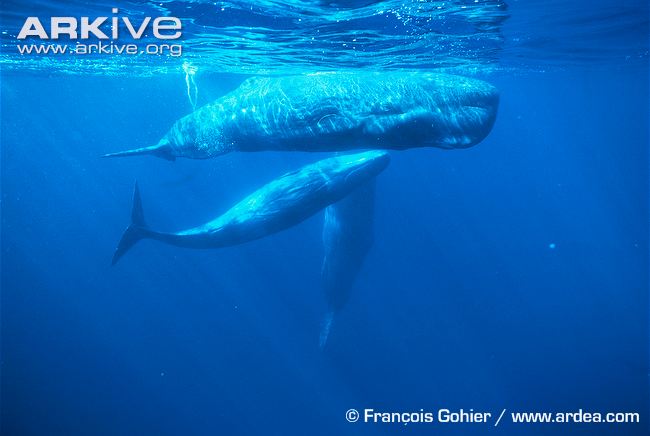Reproduction
The sperm whale (Physeter Macrocephalus) demonstrates very slow growth throughout its life (Evans and Hindell, 2003). Females do not reaching full maturity until the reach around 30 years of age. While males will not reach full maturity until about 50 years (Connor et al. 1998). The sperm whales, just like all mammals that we know of today, go through sexual reproduction where sperm and egg must be brought together to produce an offspring (gametic life cycle). After the initial conception of the fetus, the fetus undergoes a gestation phase where it grows inside of the female’s body until the offspring is able to survive in the ocean. The gestation phase normally lasts anywhere between 14 and 16 months with sperm whales (Evans and Hindell 2003). After the gestation phase is over, the female gives birth to the fetus and for the next 24 months the calf goes through a weaning phase. In the weaning phase, the calf is almost completely dependent on the mother for food. Before one year of age, the young sperm whale may be able to consume whole food such as fish or cephalopods, which is the main food source in a sperm whales diet.
After the weaning stage is over, which usually lasts about 24
months, if the offspring is male, he will leave the group of females
once he reaches about six years of age. As these whales age and
mature, the whales begin moving from larger groups to smaller groups
and eventually become solitary creatures. Males tend to migrate to
less tropical areas  and will focus their energy
on growing and maturing, rather than breeding. Even though males are
sexually mature around ten years of age, they do not have the size,
strength or experience to outcompete the older, more physically
mature males for the females (Connor et al. 1998). Only about 10-25%
of sexually mature males are able to reproduce. Usually, the first
time a male sperm whale searches for a mate is when they are between
25 and 27 years of age. This is when they are physically and
psychologically mature enough to be able to compete with the older
males for the few breeding opportunities.
and will focus their energy
on growing and maturing, rather than breeding. Even though males are
sexually mature around ten years of age, they do not have the size,
strength or experience to outcompete the older, more physically
mature males for the females (Connor et al. 1998). Only about 10-25%
of sexually mature males are able to reproduce. Usually, the first
time a male sperm whale searches for a mate is when they are between
25 and 27 years of age. This is when they are physically and
psychologically mature enough to be able to compete with the older
males for the few breeding opportunities.
If the young sperm whale was female, she would go through the
same weaning stage as the male (24 months). But, instead of leaving
the group after six years, she would most often stay with the group
of females she was born with and move around as a large pod
throughout her maturation. Females typically become sexually mature
around 8-10 years of age and will stay mainly in tropical waters.
Shortly after females reach this point in their lives, they will
begin producing offspring. After a whale is born, the mother whale
will generally spend about two years (24 months) on the weaning
stage and after that, there is usually a resting period between
reproductive cycles that lasts between 0.75 and 2.75 years (Evans
and Hindell 2003). Because of this long time period it takes to
produce offspring, females are only expected to produce 4 or 5
calves in their life time.
age and will stay mainly in tropical waters.
Shortly after females reach this point in their lives, they will
begin producing offspring. After a whale is born, the mother whale
will generally spend about two years (24 months) on the weaning
stage and after that, there is usually a resting period between
reproductive cycles that lasts between 0.75 and 2.75 years (Evans
and Hindell 2003). Because of this long time period it takes to
produce offspring, females are only expected to produce 4 or 5
calves in their life time.
Males and females are vastly different in sperm whale populations. Males may reach up to 45 tons while females will only reach about 15 tons. This is extreme sexual dimorphism. With the males evolving to be larger because they need to be larger and stronger in order to fight off other large, mature males in order to win a mate. Therefore the larger sperm whales are able to pass on their genes to the younger generations.
Back to the homepage, or learn more about the interactions Physeter macrocephalus has with other organisms.